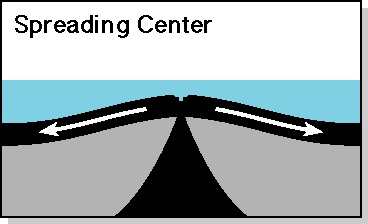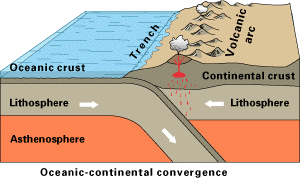Tectonic Background
Following is a brief summary of how the earth works. This is only a simplified, regional overview - reality tends to be far more complex.
If you are unfamiliar with any of the following general terms or concepts, you may wish to jump to the indicated links as you proceed through this overview, or return to the background section and review some of them now before beginning.
Tectonics
The study of earth processes which result in the creation and deformation of magma and rock
From an extremely regional point of view...
It seems certain that the earth rapidly gets hotter as you go deeper into the crust, and soon reaches a temperature where even the rocks will melt. We call the liquid form of rock "magma," in the same way that we call the liquid form of ice "water." In simple terms, the earth is just a large ball of magma which has crystallized into solid rock where it's exposed to the coldness of space. The stuff inside isn't really a "liquid" (the pressure is far too great for that), but whatever is down there probably isn't a "solid" either, at least as we understand the term here on the surface. Because of this semi-rigid plastic state, atoms, ions and other particles can ooze around (albeit very slowly). As a result, the earth appears to be zoning itself by density: the heaviest stuff is migrating towards the center, with the lighter "scum" floating to the surface. This process, called differentiation, is probably still occurring and has resulted in the earth's high density iron/nickel core, as well as the very thin surface veneer of solid rock we call the crust. Because of the heat and pressure beneath the surface, this crust is constantly being subjected to stresses which break it up and push, squeeze, and pull the pieces in all directions.
The earth's crustal sections are called plates. Plates come in a wide variety of sizes, ranging from micro-platelettes to chunks the size of North America. They are primarily composed of two fundamentally different types of rock: basalt or granite. Both basalt and granite are igneous rocks which have crystallized from magma: the molten (liquid) phase of solid rock. Basalt, an extrusive volcanic rock, is dark and heavy (specific gravity 3.3), and generally forms the relatively low-elevation crust beneath the ocean basins. Floating in this sea of basalt are huge rafts of granite, an intrusive rock. Because granite is less dense than the seafloor basalt (s.g. 2.7), it tends to ride higher in the crust, and generally forms the major land masses. Most of the earth's major crustal plates are mixtures of both basalt and granite, as well as many other types of rock in lesser amounts.
Poorly understood forces cause these rigid crustal plates to move, relative
to each other, over the higher density plastic material which is thought
to occur beneath the crust. Tectonic activity (earthquakes, volcanoes,
and mountain building in general) is common at plate boundaries, where
the edges of two (or more) plates are in contact along huge linear zones
of faulting. Plate tectonics
is the study of these crustal slabs, and how they interact at their edges.
Three (3) relative motions are possible: pulling apart, crashing together,
and sliding side-to-side against
each other. This is because different plates move at different velocities,
ranging from one (1) to greater than ten (10) centimeters per year. This
may not seem like much, but over
the course of geologic time it can have profound effects. With the
help of friction and Newton's 1st Law of Motion, the earth does its best
to keep the edges of the plates from slipping. But, as the plates continue
to move and stress along the fault increases to the breaking point, the
fault will rupture, the accumulated strain will be released in a seismic
event (earthquake), and the plates will shift along the boundary...
only to lock-up again and begin the process anew. The amount of energy
involved here is immense beyond our ability to comprehend, and surely beyond
our ability to restrict or control. All we can do is study the process,
try to keep out of the way, and, if we can't, hang on tight.
Let's get back to the rocks for a bit...
 As mentioned elsewhere,
I like to think of basalt as the blood of the earth. It's what comes out
when the earth's crust has been cut all the way through. Basaltic magma
and rock are considered to be mafic,
a made-up word indicating the presence of significant amounts of the relatively
heavy elements magnesium (ma) and iron (fic), along with the ever-present
silica and oxygen. Basalt commonly
forms where two plates are moving away from each other, and deep cracks
(rifts) are opened through the crust. These spreading
centers allow partially differentiated magma from the upper mantle
to rise to the surface and cool, in an attempt to heal the wound. An excellent
example is the Mid-Atlantic Ridge, an undersea chain of volcanoes which
extends north and south along the entire length of the Atlantic Ocean.
This spreading center is responsible for the separation of the Americas
from Europe and Africa.
As mentioned elsewhere,
I like to think of basalt as the blood of the earth. It's what comes out
when the earth's crust has been cut all the way through. Basaltic magma
and rock are considered to be mafic,
a made-up word indicating the presence of significant amounts of the relatively
heavy elements magnesium (ma) and iron (fic), along with the ever-present
silica and oxygen. Basalt commonly
forms where two plates are moving away from each other, and deep cracks
(rifts) are opened through the crust. These spreading
centers allow partially differentiated magma from the upper mantle
to rise to the surface and cool, in an attempt to heal the wound. An excellent
example is the Mid-Atlantic Ridge, an undersea chain of volcanoes which
extends north and south along the entire length of the Atlantic Ocean.
This spreading center is responsible for the separation of the Americas
from Europe and Africa.
 Granite, on the other hand,
is an intrusive igneous rock. Granitic rocks form deep within the crust
and are associated with regions where two plates are moving towards each
other. A classic example exists along the western edge of South America,
where the South American plate meets the Pacific Ocean. In this situation,
where the collision is between a thick continental plate and a much thinner
oceanic plate, the heavier oceanic crust is forced beneath the lighter
continental materials along a deep trench called a subduction
zone (imagine a head-on collision between a Mac truck and a Volkswagon
and you've got the general idea). These active
continental margins are pretty exciting places, and can involve some
mighty impressive displays of stress, directed pressure, and heat. During
the subduction process, and as mafic oceanic crust descends deeper into
the earth, it is subjected to increasing heat and pressure, which can lead
to re-melting and the formation of new magma. This allows the differentiation
process to continue, and gives the higher density mafic elements which
got trapped at the surface the chance to resume their quest for the center
of the earth. Take the silica-rich, iron-poor magma which remains near
the surface, carefully mix in some continental debris and water (which
are subducted along with the basalt), and the end result is the formation
of intermediate and / or felsic magma.
Granite, on the other hand,
is an intrusive igneous rock. Granitic rocks form deep within the crust
and are associated with regions where two plates are moving towards each
other. A classic example exists along the western edge of South America,
where the South American plate meets the Pacific Ocean. In this situation,
where the collision is between a thick continental plate and a much thinner
oceanic plate, the heavier oceanic crust is forced beneath the lighter
continental materials along a deep trench called a subduction
zone (imagine a head-on collision between a Mac truck and a Volkswagon
and you've got the general idea). These active
continental margins are pretty exciting places, and can involve some
mighty impressive displays of stress, directed pressure, and heat. During
the subduction process, and as mafic oceanic crust descends deeper into
the earth, it is subjected to increasing heat and pressure, which can lead
to re-melting and the formation of new magma. This allows the differentiation
process to continue, and gives the higher density mafic elements which
got trapped at the surface the chance to resume their quest for the center
of the earth. Take the silica-rich, iron-poor magma which remains near
the surface, carefully mix in some continental debris and water (which
are subducted along with the basalt), and the end result is the formation
of intermediate and / or felsic magma.
 If this new magma can find
a path of weakness (generally not a problem where two plates are grinding
into each other) it can erupt from the surface as lava and form volcanic
mountains. It is also likely that much of it cools at depth, resulting
in the formation of huge masses of intrusive rock, and the addition of
new granitic material to the edge of the continental plate. The Andes Mountains
are being formed due to these processes, and will continue to experience
earthquake and volcanic activity as long as subduction is taking place
offshore. A similar tectonic setting exists where the eastern edge of the
Asian continent runs into the Pacific Ocean. In this situation, the collision
is between two oceanic plates and the subduction occurs further offshore.
This results in the creation of volcanic islands like Japan, the Aleutians,
and others which form the arcs of volcanoes bordering the western Pacific
Ocean.
If this new magma can find
a path of weakness (generally not a problem where two plates are grinding
into each other) it can erupt from the surface as lava and form volcanic
mountains. It is also likely that much of it cools at depth, resulting
in the formation of huge masses of intrusive rock, and the addition of
new granitic material to the edge of the continental plate. The Andes Mountains
are being formed due to these processes, and will continue to experience
earthquake and volcanic activity as long as subduction is taking place
offshore. A similar tectonic setting exists where the eastern edge of the
Asian continent runs into the Pacific Ocean. In this situation, the collision
is between two oceanic plates and the subduction occurs further offshore.
This results in the creation of volcanic islands like Japan, the Aleutians,
and others which form the arcs of volcanoes bordering the western Pacific
Ocean.
Working together, the spreading and subduction processes make for a great global balance (the earth is really into balance and is good at it - it's been practicing for a very long time). New basaltic crust is produced at the spreading centers, and then consumed (or eaten, if you will) at the subduction zones, where it is purified and converted into granite. This is a real good thing, too! Without both processes the earth would either expand like a balloon (and pop?), or it would eventually eat itself into non-existence. Either result would cause problems for those of us destined to exist on its surface.
In any event, the cores of the continental land masses are primarily granite and related igneous rocks formed in subduction zones, and very high grade metamorphic rocks which are often the remains of seafloor crust (ophiolite) which got caught up in the mess. The continents represent the purified end product of 4.6 billion years of differentiation, so they're worth a bit of respect. Over the course of geologic time these "cratons" will continue to purify and grow by adding newly created material along the active edges. Click here for more information on cratons and greenstone belts.
You are GeoManiac number since April 1, 1997